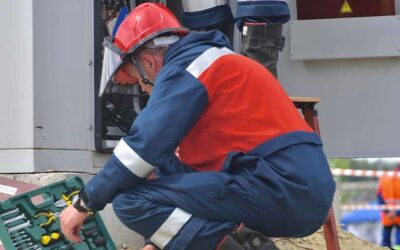Most of us have heard of ultraviolet (UV) light. Thanks to sunscreen ads and common knowledge, we also know that there are dangers associated with UV light exposure. But did you know there are different types of UV light?
UVA, UVB, and UVC light are all subsets of ultraviolet lighting that occur naturally. However, each has their own intensities and properties that make them harmful in different ways. Below, the experts with Action Services Group explain the differences between UVA, UVB, and UVC light, as well as the dangers associated with them.
Understanding the Dangers
Light wavelengths are measured in nanometers (nm). Different wavelengths affect visibility and intensity. Visible light, for example, is those which range between 380nm and 780nm.
UV light, however, falls just short of this. In fact, when talking about UV light, you are only discussing light with wavelengths that measure between 100 nm to 400 nm. As mentioned above, this is broken into subcategories known as UVA, UVB, or UVC.
UVA
UVA wavelengths fall between 315 nm and 400 nm. These are the longest forms of UV wavelengths. UVA wavelengths are those that are most likely to cause skin aging and wrinkles. Why? Because UVA rays are some of the only ones that occur naturally, leaving humans exposed for longer periods of time.
UVA rays have been linked to cancer as they are able to penetrate the skin’s dermis layer quickly, which is why they are known to help tan the skin. Unlike UVB and UVC wavelengths, UVA rays are also able to penetrate through glass and clouds. This means your windshield and windows provide little protection from exposure. (Hence the reason experts in the medical field always urge you to apply sunscreen, even if you are not spending a day at the beach!)
UVB
UVB refers to light with wavelengths between 280 nm and 315 nm. While fewer of these rays penetrate the earth’s ozone layer, those that do are more intense than UVA light. Because of this, UVB light is often cited as the source that causes sunburn. In fact, UVB rays can burn the top layer of your skin, known as the epidermis layer, in as little as 15 minutes.
UVB wavelengths can vary based on the time of day, as well as the season. This is because they typically only break through the ozone layer while the earth is closest to the sun. Because they can damage the skin, UVB wavelengths have been known to age skin and lead to skin cancer.
UVC
UVC wavelengths are the shortest on the UV spectrum; they range from 100 nm to 280 nm. Because of this, they are also the most intense UV wavelengths. While the Earth’s ozone layer fully blocks these from naturally entering our atmosphere, there are Artificial UVC Applications should be used with caution and with proper measures taken to prevent prolonged exposure.
Artificial UVC
For the most part, the earth’s atmosphere prevents wavelengths below 350 nm, which means that most of all UV light must be artificially created. (Of the UV light that does enter the earth’s atmosphere, 95% are UVA wavelengths and the remaining 5% are UVB.) Although this might seem like these rays aren’t harmful due to natural UV lighting being unlikely, artificial lighting is just as harmful.
You may find yourself asking why artificially UVC lighting would be desired. After all, knowing the dangers associated with UVA and UVB lighting may make it seem foolish to artificially create an even more intense UVC light source. However, there are many different UVC applications that exist today and require the use of an artificial source. Many of these applications are quite common and you are likely familiar with them. This includes things like:
- Older-Style Tanning Beds
- Lasers
- Mercury Lamps
- Welding Torches
- Germicidal Lighting
Of all the applications listed above, however, you may find yourself least familiar with germicidal UVC lighting. These applications, while seem helpful, can be more dangerous than helpful if not used with extreme caution.
There are a lot of terms in this blog, and you might not be up to date on your UVC terminology. So, what is Ultraviolet Germicidal Irradiation or Germicidal UVC Lighting? You can find out the answer to those questions and more here!
The Alternative to Germicidal Lighting
UV light is known to damage, if not kill microorganisms. How? UV wavelengths are able to damage the RNA and DNA of microorganisms in a way that prevents them from multiplying. This, in turn, leads to the elimination of these microorganisms as they are no longer able to reproduce and spread.
UVA wavelengths are the least effective when it comes to disinfection. UVB, which is slightly more intense, can help disinfect some minor bacteria. Of all the UV wavelengths, however, UVC is considered the strongest and most effective at disinfection, though still harmful.
Instead of adding a potentially dangerous application to your facility, an air purification system is the safe viable option. These systems offer building occupants a sense of safety as they purify the air from allergens, bacteria, and viruses (including the Covid-19 virus). Healthy buildings need to have a robust HVAC or air filtration system that is capable of filtering common pollutants like dirt, pollen, and dust out of the air, along with pathogens like COVID-19
We have done the leg work on making sure we offer you the best air purification product on the market. But don’t take our word for it, we have clinical testing to prove it. To make this easier, we have broken down the terms, controls, and the findings in a way that anyone can understand. To see the results of the Halo Smart P air purification system efficacy report, click here.
Dangers of UV Light
We have talked about the range in UV wavelength intensities. All are capable of causing skin irritation, tans, and burns, as well as the potential for premature aging, cancer, and eye damage. But which is truly the most dangerous?
There really is not one concise answer to this question. UVA wavelengths, while being the least intense, are ones we are exposed to every day. This means they are most likely to cause long term damage since many of us fail to take preventative measures. (After all, do you apply sunscreen before going for a drive? These rays penetrate your windshield, exposing your eyes and skin to their dangers the entire time.) UVB rays, which also penetrate the earth’s atmosphere, are more intense. While they are more likely to cause sunburn, they take a certain level of exposure before this occurs. (However, intense sunburns can lead to extreme and permanent damages to your skin more quickly than years of UVA exposure.) Because of this, UVB exposure is more likely to lead to skin cancer than UVA or UVC light.
Protect Yourself
Broad-spectrum sunscreen, clothing, and sunglasses can help prevent damage caused by UVA and UVB light. Because UVA light can penetrate your glass and clouds, experts recommend sunscreen applications even when indoors or going out on cloudy days. Reapplication of sunscreen, which is also overlooked, is equally as important since the skin eventually absorbs the initially applied protective layer and leaves you exposed.
Air Purification with Action Services Group
At Action Services Group, we strive to ensure every facility we work with is ready with the best defenses. This includes being ready to reduce airborne viruses. As a national distributor of the Erlab Halo Smart P premier air filtration station, we can help keep your facility’s occupants in the healthiest environment possible.
If you are looking to increase the safety of your facility and are interested in learning more about the importance of proper air filtration, contact Action Services Group today. Call 610-558-9773 or email [email protected], you can also schedule a call by clicking the button below.







































0 Comments
Trackbacks/Pingbacks